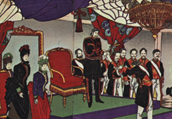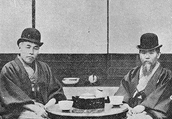HOME > Evolution of the Meiji State : Outline
Outline
- a. Drafting the Meiji Constitution
- b. Establishment of the Imperial Diet
- c. Evolution of Diet Politics
- d. Foreign Relations in the Meiji Era

Nishiki-e of the constitution promulgation celemony, depicted by YOSHU Chikanobu (Meiji 22) (Special Collection of the Tokyo Metropolitan Central Library). From "Nishiki-e ni Miru Meiji Tenno to Meiji Jidai"
The Imperial edict sanctioning the establishment of a national assembly in 1890 (Meiji 23), (following the Political Crisis of 1881 (Meiji 14) after which work proceeded apace on the framework for a constitutional state. All the while, the activities of political parties gained in strength, with the formation of the Liberal Party (Jiyuto) and Constitutional Progressive Party (Rikken Kaishinto). In 1884 (Meiji 17), the Peerage Law was enacted, laying the foundations of the future Upper House, and the Cabinet system was launched in the following year. ITO Hirobumi, then made his study tour of Europe investigating various countries' constitutions, while drafts of constitution were also being drawn up by others in the Government. All of these activities led to the promulgation of the Constitution of the Empire of Japan (Meiji Constitution) on February 11, 1889 (Meiji 22).
Historical materials and Description
 2-1Imperial Rescript Establishing a Constitutional Form of Government
2-1Imperial Rescript Establishing a Constitutional Form of Government
- Imperial Rescript Establishing a Constitutional Form of Government
 2-2The Chamber of Elders' Conception of a Constitution
2-2The Chamber of Elders' Conception of a Constitution
- Proposal for a Japanese National Constitution
 2-3Political Crisis of 1881 (Meiji14)
2-3Political Crisis of 1881 (Meiji14)
- OKUMA Shigenobu's Report to the Emperor (copy)
 2-4IWAKURA Tomomi's Conception of a Constitution
2-4IWAKURA Tomomi's Conception of a Constitution
- Discussion of Outline of Constitution
 2-5ITO Hirobumi's Constitutional Study Mission to Europe
2-5ITO Hirobumi's Constitutional Study Mission to Europe
- Imperial Order to Dispatch Mission Head Plenipotentiary ITO to Europe to Study Constitutional Forms of Government
 2-6Birth of the Cabinet System
2-6Birth of the Cabinet System
- Authority of the Cabinet Edict
 2-7Toward the Enactment of the Constitution
2-7Toward the Enactment of the Constitution
- Natsushima Draft Proposal
- Constitution of the Empire of Japan (clean copy), March Proposal
The impending establishment of the Diet, saw the Daido Danketsu (Grand Coalition) Movement surge with the aim of uniting the elements of the People's Rights Movement; eventually, it led to the formation of the Constitutional Liberal Party (Rikken Jiyuto), with members of the former Liberal Party at its core. When the Imperial Diet was inaugurated in 1890 (Meiji 23), the Government, led by the Satsuma-Choshu clique, adopted the so-called "transcendental" (chozen-shugi) policy of keeping distance from all political parties. That stance led to fierce confrontation between the Government and the popular parties in the first session of the Diet.
Historical materials and Description
 2-9Transcendental Cabinets
2-9Transcendental Cabinets
- Prime Minister KURODA's Speech on the Occasion of the Promulgation of the Constitution
 2-10Establishment of the Constitutional Liberal Party
2-10Establishment of the Constitutional Liberal Party
- [Items to be Studies for the Constitutional Liberal Parties Platform]
 2-11Selection of Members of the House of Representatives and the House of Peers
2-11Selection of Members of the House of Representatives and the House of Peers
- House of Representatives Member Certificate
- List and Ballot of Viscount Candidates for Election to the House of Peers
 2-12Opening of the Imperial Diet
2-12Opening of the Imperial Diet
- Letter from INOUE Kowashi to ITO Hirobumi
 2-13Election Interference
2-13Election Interference
- List of Candidates for Election to the House of Representatives
 2-14Imperial Edict for Reconciliation
2-14Imperial Edict for Reconciliation
- [Draft of Imperial Edict for Reconciliation]
 2-15National Diet Member Sugoroku (Game of Dice)
2-15National Diet Member Sugoroku (Game of Dice)
- Sugoroku (game of dice) Lampooning Diet Members
 2-16Imperial Diet
2-16Imperial Diet
- Nishiki-e of the Imperial Diet Building

ITO Hirobumi and OKUMA Shigenobu, at ITO's villa in Oiso. From "Okumako 85nenshi Vol.2"
After the 1st Sino-Japanese War of 1894-95, a part of the Satsuma-Choshu ruling elite entered into a partnership with the political parties, in order to promote the policies of postwar development, which were based on the twin pillars of industrialization and military spending. The ruling elite was soon realigned, divided into those who supported ITO Hirobumi and those who supported YAMAGATA Aritomo. There followed a series of complicated and fragile coalitions that led to Japan's first party based cabinet, the 1st OKUMA Cabinet (the so-called Waihan Cabinet). It, however, lasted for only a brief time. In 1900 (Meiji 33), the Association of Friends of Constitutional (Rikken Seiyukai) was formed under ITO's leadership, with both political parties and bureaucratic forces serving as its core. After the Russo-Japanese War of 1904-05, KATSURA Taro and SAIONJI Kinmochi alternated in controlling the Government, giving rise to the so called "Kei'en" (KATSURA-SAIONJI) Era.
Historical materials and Description
 2-17Closer Relationship between the Political Parties and the Government
2-17Closer Relationship between the Political Parties and the Government
- Outline of Prime Minister ITO's Statement of His Policies
 2-18Birth of the "Waihan" (OKUMA-ITAGAKI) Cabinets
2-18Birth of the "Waihan" (OKUMA-ITAGAKI) Cabinets
- Proclamation
- Record of ITO-OKUMA-ITAGAKI Meeting
 2-19Formation of the Rikken Seiyukai
2-19Formation of the Rikken Seiyukai
- Draft Proposal of the Rikken Seiyukai By Laws
- Rikken Seiyukai By Laws
 2-20Formation of the Social Democratic Party (Early Socialism)
2-20Formation of the Social Democratic Party (Early Socialism)
- Copy of the Notification of Social Democratic Party Formation, and Party By Laws
 2-21The "Keien" (KATSURA-SAIONJI) Era
2-21The "Keien" (KATSURA-SAIONJI) Era
- Letter from SAIONJI Kinmochi to KATSURA Taro
- Letter from SAIONJI Kinmochi to KATSURA Taro
The Meiji era was also an eventful period in foreign affairs for Japan. Tensions continued with Qing (Ching) China over the control of the Korean peninsula, leading to the outbreak of the 1st Sino-Japanese War. China's defeat saw, Russia penetrate into the Korean Peninsula. These were attempts at accommodation between Japan and Russia, but ultimately the Russo-Japanese War broke out. After its victory in the war, Japan consolidated its control over the Peninsula, and annexed of Korea in 1910 (Meiji 43). Meanwhile, with the revision of the extraterritoriality treaties in 1894 (Meiji 27), extraterritoriality was abolished in 1899. And tariff (customs) autonomy was achieved in 1911 (Meiji 44), the longstanding issue of treaty revision finally was fully resolved.
Historical materials and Description
 2-22Treaty Revision
2-22Treaty Revision
- Draft of a Directive Telegraphed to Legations Overseas
 2-23Sino-Japanese War
2-23Sino-Japanese War
- Draft of Kenken Yoroku
- HAYASHI Tadasu's letter to MUTSU Munemitsu
 2-24The Hokushin Incident
2-24The Hokushin Incident
- KATSURA Taro Autobiography, Volume Three (Section on the Hokushin Incident)
 2-25Anglo-Japanese Alliance
2-25Anglo-Japanese Alliance
- Entente with the Great Britain and Germany, and the Russo-Japanese Alliance
 2-26Russo-Japanese War
2-26Russo-Japanese War
- Notes from the Front, No. 1
 2-27Japan's Annexation of Korea
2-27Japan's Annexation of Korea
- KATSURA Taro Memorandum
 2-8
2-8